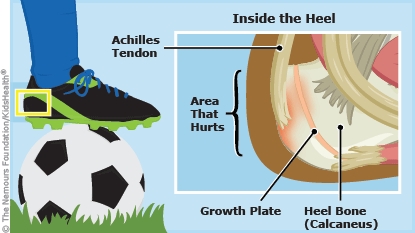Sever's Disease: How to Care for Your Child
Sever's disease is swelling and irritation of the growth plate in the heel. Growth plates are layers of cartilage near the ends of bones where most bone growth happens. Kids with Sever's disease have heel pain. They may also have stiffness, swelling, and redness and walk with a limp. With rest, the condition usually goes away within a few months and doesn't cause lasting problems.


Activity
-
Your child needs to cut down on or avoid all activities that cause pain. Walking and non–weight-bearing exercises (like swimming) are usually OK.
-
When your health care provider says it's OK, your child can gradually increase activities. If they have no pain, they can continue to add more activities and training.
-
If an activity causes pain or swelling, your child should stop doing it and put ice wrapped in a towel on the heel for about 20 minutes. They should continue icing several times a day for a few days. They can try the activity again after the heel stops hurting or switch to a less intense activity.
To help with pain and swelling:
-
Give your child acetaminophen (Tylenol® or a store brand), ibuprofen (Advil®, Motrin®, or a store brand), OR naproxen (Aleve®, Naprosyn®, or a store brand) as needed for pain. Follow the directions on the label for how much to give and how often.
-
Place ice wrapped in a towel on the heel for about 20 minutes several times a day. Do not put ice directly on the skin.
-
Wrap the foot in an elastic bandage or have your child wear a compression sock.
-
Have your child wear shoes that are open in the back (but not flip-flops, which can cause foot irritation).
Follow your health care provider's advice for:
-
Any movement exercises or stretches your child should do and any activities to avoid.
-
Using heel gel cups or other shoe inserts to lower stress on the heel.
-
Whether your child should wear a walking boot or needs a cast to limit the movement of the ankle/heel.
-
Whether your child should go to a bone doctor (orthopedist), sports medicine doctor, or physical therapist to help them build strength and flexibility and create a plan for returning to full activities and sports.
-
When your child can return to sports. Usually, this is when the sports activity does not cause pain while your child does it or afterward.
-
When your child should follow up.


What causes Sever's disease? Sever's disease usually happens during the growth spurt of puberty (9–14 years old) when the bones, muscles, and tendons (bands of connective tissue that connect muscles to bones) grow at different rates. The tendons can get tight, and in kids who do sports that involve a lot of running or jumping (such as basketball, gymnastics, and track), they pull on and injure the growth plate in the heel.
Less often, Sever's disease can happen from standing too long, which puts constant pressure on the heel.
What can help prevent Sever's disease from coming back? It can help to have your child:
-
Avoid heavy or high-heeled shoes and flip-flops.
-
Limit how much they wear cleats.
-
Stretch before and after activity and sports.
-
Place ice wrapped in a towel on the heel for about 20 minutes after activity and sports. Do not put ice directly on the skin.
-
Use special shoe inserts (as recommended by your health care provider).
-
Lose weight (if overweight).